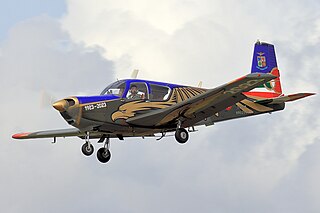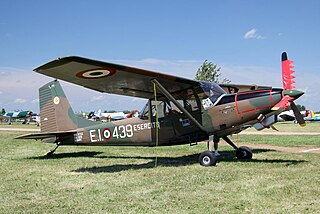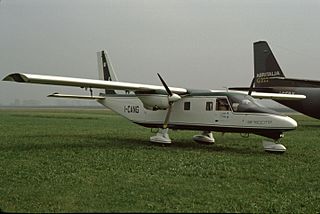
The PZL TS-8 Bies (Devil) is a Polish trainer aircraft, used from 1957 to the 1970s by the Polish Air Force and civilian aviation.

The Glaser-Dirks DG-400 is a single-seat self-launching motorglider that was produced by Glaser-Dirks between 1981 and 1992. It was the first self-launching motorglider with retractable engine and propeller to be produced in large numbers.

The Bellanca Viking and Super Viking are a series of single-engine, four-seat, high performance, retractable gear aircraft manufactured in the USA during the 1960s and 1970s. The aircraft developed through modifications of classic designs by the aviation pioneer Giuseppe Bellanca. A total of 1,356 Vikings have been produced with most production between 1968 and 1975.
The Aeronca Model 9 Arrow was a low-wing all-metal cabin monoplane with retractable landing gear. It was marketed to returning pilots from World War II and unveiled in 1947 but never went into production.

The Cessna Model 411 is an American twin-engined, propeller-driven light aircraft built by Cessna Aircraft. It was that company's largest business aircraft to enter production when it first flew in 1962.

The All American 10A Ensign was a two-seat light plane built in the United States shortly after World War II. It was a low-wing, all-metal cantilever monoplane with fixed tricycle undercarriage and which seated its pilot and passenger side by side under an expansive bubble canopy. Due to the glut of military surplus aircraft on the civil market after the war, All American was unable to attract buyers and no production ensued.
The Anderson EA-1 Kingfisher is a US two-seat amphibious aircraft designed and marketed for homebuilding. It was the work of Earl William Anderson, a Pan Am airline captain, who flew the prototype on 24 April 1969. By 1978, 200 sets of kits for the plane had been sold, and 100 Kingfishers were reported to be under construction. The aircraft is a shoulder-wing monoplane with a flying boat hull and outrigger pontoons. On land, it uses retractable tailwheel undercarriage. The single engine with a tractor propeller is mounted in a nacelle above the wing. Some builders utilize the wings from a Piper Cub rather than making their own.

The Bellanca 19-25 Skyrocket II was a prototype light airplane built in the United States in the 1970s. Despite its advanced design and exceptionally good performance, it never achieved certification or entered production.
The Boisavia B.260 Anjou was a four-seat twin-engine light aircraft developed in France in the 1950s. It was a low-wing cantilever monoplane of conventional configuration with retractable tricycle undercarriage. Intended by Boisavia as a touring aircraft, it did not find a market and only the single prototype was constructed. At this point, the firm sold the design to SIPA, which modified the design and re-engined it with Lycoming O-360 engines, but found that they could not sell it either. At a time when the twin-engine light plane market was already dominated by all-metal American aircraft, the Anjou's fabric-over-tube construction was something of an anachronism, and all development was soon ceased. Plans to develop a stretched version with three extra seats and Potez 4D engines were also abandoned.

The SIAI-Marchetti S.205 is an Italian four-seat, single-engine, light airplane, manufactured by SIAI-Marchetti. The S.205 made its maiden flight in 1965. The Italian Air Force employs a version called S.208.

The SIAI-Marchetti S.210 was a 1970s Italian twin-engined cabin-monoplane designed and built by SIAI-Marchetti as a development of the single-engined SIAI-Marchetti S.205.

The SIAI-Marchetti SM.1019 is an Italian STOL liaison monoplane built by SIAI-Marchetti for the Italian Army. It is a turboprop-powered derivative of the Cessna O-1 Bird Dog.

The Vulcanair SF.600 Canguro was a feederliner developed in Italy in the late 1970s. Despite a number of attempts to put the aircraft into series production, only a small number were ever built. The Canguro was a high-wing cantilever monoplane of conventional configuration with a fuselage of rectangular cross-section and a high-set tail. The tricycle undercarriage was not retractable, and its main units were carried on sponsons on the fuselage sides. SIAI Marchetti provided funding towards the construction of the prototype, and constructed this aircraft at the former Aviamilano plant. After flight testing proved positive, the type was put on sale, but failed to attract buyers in any number, even when the original piston engines were exchanged for turboprops and retractable undercarriage was offered as an option.

The Italair F.20 Pegaso was a twin-engine utility aircraft designed by Stelio Frati and built in Italy in 1971.

The PZL M-17 "Duduś Kudłacz" was a Polish twin-boom pusher general aviation and trainer aircraft of 1977, which remained a prototype.

The IAR-46 is a very light two-seater airplane for flight schools, training and tourism. Construction uses conventional riveted joints. The seats are arranged side by side, the conventional left seat being the pilot or student pilot seat. The aircraft has a low trapezoidal wing, empennage in "T" configuration, semi-retractable landing gear (mechanical), with the tailwheel connected to the rudder.

The Jeffair Barracuda is a high-performance sporting monoplane that was developed in the United States in the 1970s and is marketed for homebuilding. Designed and built by Geoffrey Siers, the prototype won the prize for "Most Outstanding New Design" at the EAA Fly-in in 1976. It was a low-wing cantilever monoplane of wooden construction with retractable tricycle undercarriage and side-by-side seating for two. Around 150 sets of plans had sold by 1977.
The Partenavia P.55 Tornado was a 1950s Italian high-performance competition and touring monoplane built by Partenavia. The Tornado was a small mid-wing cantilever monoplane with a retractable tricycle landing gear. The aircraft was powered by a nose-mounted Lycoming O-320 piston engine.

The Valentin Taifun is a two-seat self-launching sailplane designed and built by Valentin Flugzeugbau GmbH of Hasfurt, Germany.

The Turbay T-3A was an Argentine twin-engined seven-seater light transport of the 1960s. A single example was built, but no production followed.
















